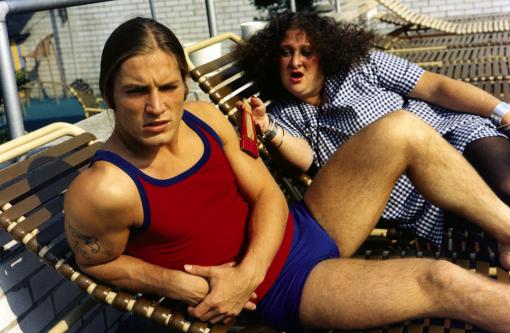
After the increasing successes of Flesh (1968), Trash (1970), and the underrated Women In Revolt (1971) Paul Morrissey’s films for producer Andy Warhol reached their zenith of mainstream acclaim with their parody of Sunset Boulevard (1950) titled Heat (1972). The “slice of life” tone and vignette structure of Flesh and Trash is discarded in favor of a more tableaux style format where characters’ lives intersect and influence each other in Heat. As much as the two earlier films were a portrait of New York City in the late sixties, Heat is a pessimist’s view of Los Angeles in the seventies.
Heat is the transition film from the classic Warhol style of My Hustler (1965), Lonesome Cowboys (1968), Chelsea Girls (1966), and Flesh (1968) into Morrissey’s genre period abroad where he’d direct Flesh For Frankenstein (1973) and Blood For Dracula (1974). Heat is Morrissey’s final film that feels at all “underground” as he moves away from the budget restraints and general milieu of that particular film culture. One could even view Trash as the dress rehearsal for Morrissey’s matured style as it emerged from under the shadow of Andy Warhol to assert itself on its own terms.
Paul Morrissey’s style is pretty unique and a personal favorite of mine amongst the pantheon of the “great auteurs”. Morrissey adores the Hollywood films of the thirties through to the mid-fifties where tinsel town was an actual dream factory of sorts. Morrissey’s movies embrace the poetry inherent to these plastic monoliths of entertainment, recreating the cinematographic gestures and cues of these self-assured classics but on a small scale. In a kind of loving homage Morrissey revels in the hollow beauty of melodramatic spectacle where he finds that the glitz and glamour of old Hollywood is in fact synonymous with debauchery of the youth movement in the post-war period.
Morrissey’s style as a director is then turned onto characters representative of this demographic as a kind of weapon designed to pinpoint the hypocrisy of such a self-absorbed society of popular culture. Joe Dallesandro, in seemingly countless variations, is forever the victim of such a society and in turn the perfect leading man for Paul Morrissey’s cinema of moral excess and depravity. In Flesh Dallesandro is treated like a starlet of old until he is objectified into cinematic oblivion. In Trash Dallesandro is the impotent and flaccid “tough guy” protagonist whose moral ambiguities ultimately strip him of all his false machismo revealing a creature that exists entirely in the fantasies of those around him. By the time Morrissey makes Heat the Dallesandro character, now known as Joey, is little more than an object discarded by the Hollywood movie machine when he’s proven to no longer be useful; sentenced to an eternity as a pool side stud.
The types that Dallesandro inhabits in Morrissey’s films all have their place in classic Hollywood. In Heat Morrissey opens a direct discourse, in terms of narrative, for the first time between “type” and the industry that manufactures them. Dallesandro’s Joey is a washed up child star “kept” by a washed up actress named Sally Todd played by Sylvia Miles. Miles, unlike the Warhol Superstars who have populated Morrissey’s films thus far, was an actress in the old Hollywood studio system. Over the course of the sixties Miles descended from films like Murder Inc. (1960) to cheap “B” pictures and bit parts. Miles’ casting in Heat mirrors literally Gloria Swanson’s casting in Sunset Boulevard albeit updated to include actual scenes of sex and nudity. It’s hard to appreciate today what a coup it was for Morrissey to get Sylvia Miles to appear in an “underground” Warhol picture.
Even though Andy Warhol’s named would appear on Paul Morrissey’s two subsequent features, Heat was the last film that the famed pop artist would have a hand in. Besides helping to fund Heat all that Warhol contributed was the basic premise. In this respect one might view Heat as Warhol’s commission of Morrissey. Though it has rarely been publicized this had been the standard operating procedure for “Warhol films” for some time. Joe Dallesandro’s participation was even a byproduct of necessity for Morrissey whose name was as linked to that of his one time muse as it was to his famous benefactor.
Curiously enough Heat has more in common with Morrissey’s later films like Mixed Blood (1984) and Spike Of Bensonhurst (1988) than the films that he made in Europe. These films not only feature Dallesandro surrogates but also the narrative motif where the protagonist arrives at an unfamiliar location and must integrate themselves in the face of resistance. It’s not much of an intellectual stretch to argue that Paul Morrissey is a true cinematic auteur. The fact that he has yet to escape Warhol in the minds of our mass culture is a shame and a true disservice to the artist.
